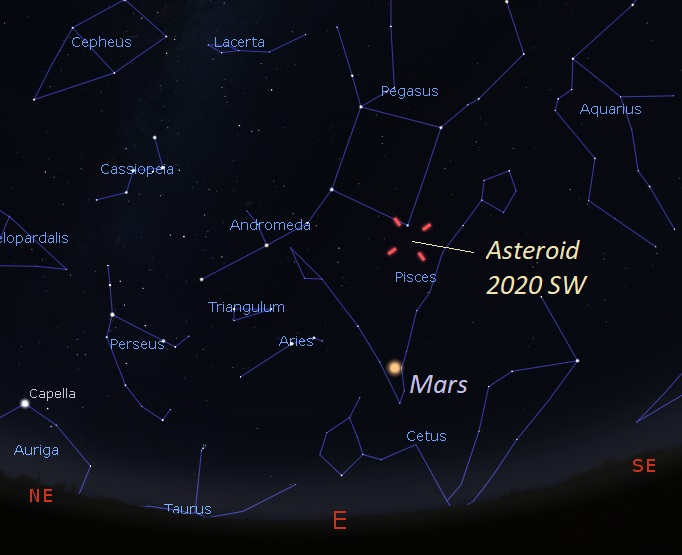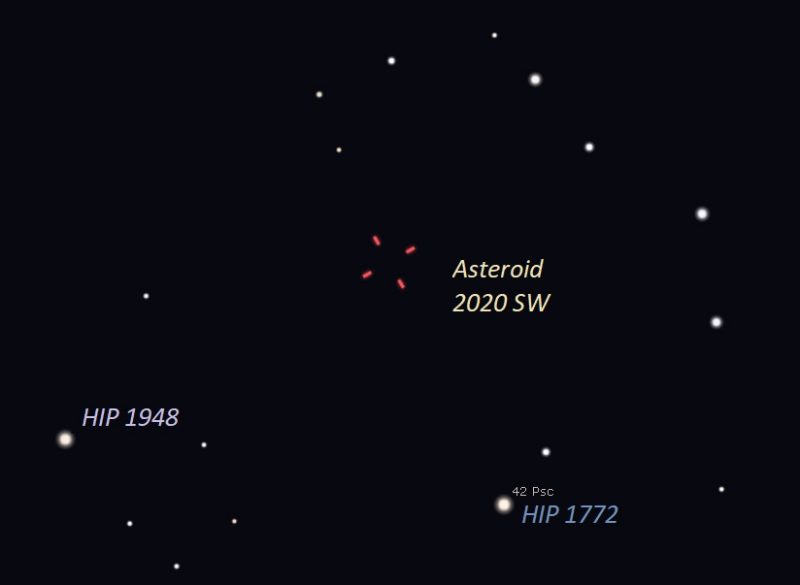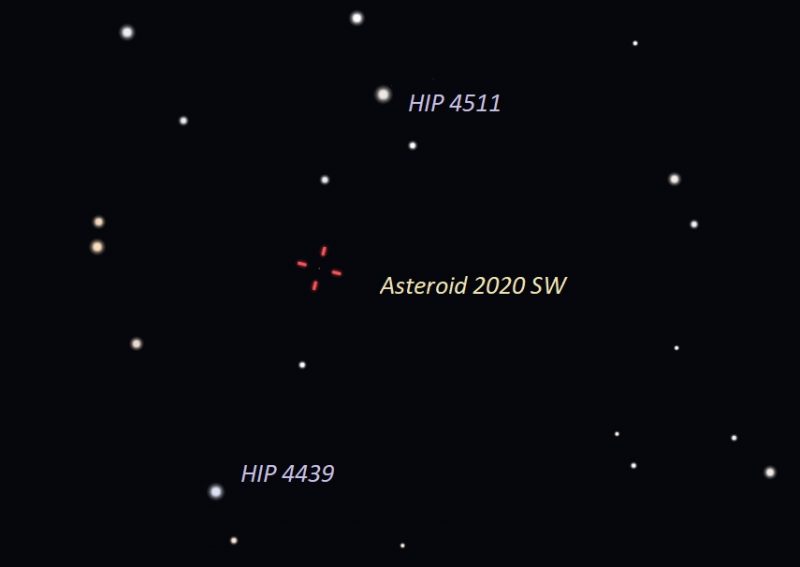
A small asteroid discovered on September 18, 2020, from Mt. Lemmon Observatory in Arizona will pass a lot closer than the moon’s distance on Thursday, September 24, 2020, passing even closer than geostationary satellites. Closest approach of this asteroid – labeled 2020 SW – should occur at around 11:18 UTC (7:18 am ET) on September 24. At closest approach, asteroid 2020 SW should pass just 7% of the moon’s distance.
Asteroid 2020 SW is estimated to be about 14 to 32 feet (about 4.5 to 10 meters) in diameter. It is brightening as it draws near, but won’t ever get bright enough to see with the eye alone. You can watch online via the Virtual Telescope Project in Rome, however, with host Gianluca Masi. The live feed is scheduled for September 23, 2020, starting at 22:00 UTC (5 p.m. CDT); translate UTC to your time.
See the poster below for more details.
Look below that for charts for telescope users.

Asteroid 2020 SW is expected to pass an estimated distance of 17,556 miles (28,254 km) from Earth. For comparison, television and meteorological satellites orbit at some 22,300 miles (35,888 km) from our planet’s surface.
Although there’s still some uncertainty in the space rock’s orbit, calculations indicate there is no risk of impact. As a result of the asteroid’s orbit’s uncertainty, closest approach might occur up to 24 minutes earlier or later than expected.
Preliminary calculations indicate that asteroid 2020 SW orbits the sun every 372 days. Its orbit is just seven days longer than Earth’s. However – despite the similarity of our orbits – calculations indicate the small asteroid will not impact Earth, at least not for the next approximately 50 years for which its orbit has been calculated.
The space rock is currently traveling at a speed of 17,336 miles per hour (27,900 km/h) or 7.75 km/s (about 5 miles/s) relative to Earth.
Asteroid 2020 SW will pass at a safe distance, probably over Australia or New Zealand, during its closest approach, as shown on the illustration below:

The asteroid will be visible through small telescopes
Asteroid 2020 SW might reach a visual magnitude of 13.0 to 13.5, too faint to be seen by the unaided eye, but within the reach of observers using a 6- or 8-inch diameter telescope – that is, a very small telescope – and also larger telescopes. The space rock is currently in the constellation of Pegasus the Flying Horse, and will then move to the constellation of Pisces the Fish.
The asteroid might still have a magnitude close to 15 on the night of Wednesday, September 23, but will gradually increase its brightness as it approaches, reaching a magnitude of around 13 to 13.5 during the first hours of Thursday, September 24, its brightest being just before dawn.
Observers using a telescope might detect the asteroid, which will look like a “star” moving very slowly because of the distance. If you are pointing the telescope at the correct position and time, carefully observe the stars’ pattern and compare it just five minutes later. If you are able to see a “star” that changed position, then it’s not a star, you have found the asteroid!



Bottom line: Small asteroid 2020 SW will pass just 7% of the moon’s distance on September 24, 2020 at around 11:18 UTC (7:18 am ET; translate UTC to your time). There is no chance it will hit Earth. Online viewing via the Virtual Telescope Project is scheduled for September 23 starting at 22:00 UTC (5 p.m. CDT). To join online, go to Virtual Telescope’s website.











